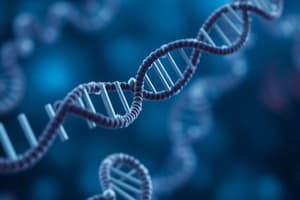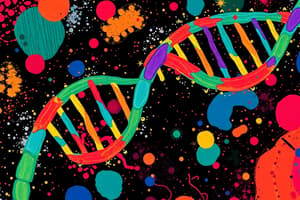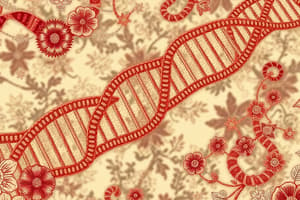Podcast
Questions and Answers
What is the primary role of exons in mRNA processing?
What is the primary role of exons in mRNA processing?
- They consist primarily of conserved splice site sequences.
- They are sequences that are removed before the RNA becomes functional.
- They are parts of the gene that contribute to the mature RNA product. (correct)
- They are intervening sequences that develop into noncoding RNA.
Which of the following best describes introns?
Which of the following best describes introns?
- They are responsible for the splicing process, facilitating exon recruitment.
- They are sequences removed during mRNA processing and account for ~95% of pre-RNA. (correct)
- They contain conserved sequences necessary for the translation of RNA.
- They are crucial for protein coding and are included in the mature RNA.
What is the significance of the 5’ and 3’ splice sites?
What is the significance of the 5’ and 3’ splice sites?
- They are the locations where ribosomal subunits attach to mRNA.
- They are highly conserved sequences that signal where splicing occurs. (correct)
- They are essential for initiating transcription of the RNA.
- They represent the boundaries of pseudogenes within the genomic sequence.
What role do exonic splicing enhancers (ESE) play in splicing?
What role do exonic splicing enhancers (ESE) play in splicing?
Approximately what percentage of human inherited diseases may result from splicing errors?
Approximately what percentage of human inherited diseases may result from splicing errors?
What is the primary role of RNA polymerase II in transcription?
What is the primary role of RNA polymerase II in transcription?
Which component is NOT required for the process of translation?
Which component is NOT required for the process of translation?
What is the fate of the primary transcript known as pre-mRNA once it is synthesized?
What is the fate of the primary transcript known as pre-mRNA once it is synthesized?
What is NOT a feature of heterogeneous nuclear RNA (hnRNA)?
What is NOT a feature of heterogeneous nuclear RNA (hnRNA)?
Which processing step involves adding a protective cap to the 5' end of pre-mRNA?
Which processing step involves adding a protective cap to the 5' end of pre-mRNA?
What is produced at the end of the transcription process?
What is produced at the end of the transcription process?
Which of the following is NOT required for translation?
Which of the following is NOT required for translation?
What is the primary function of the C-terminal domain (CTD) of RNA polymerase during transcription?
What is the primary function of the C-terminal domain (CTD) of RNA polymerase during transcription?
Which statement accurately describes heterogeneous nuclear RNA (hnRNA)?
Which statement accurately describes heterogeneous nuclear RNA (hnRNA)?
Which of the following processing events occurs to pre-mRNA?
Which of the following processing events occurs to pre-mRNA?
What is the primary function of the spliceosome during mRNA processing?
What is the primary function of the spliceosome during mRNA processing?
Which component of the spliceosome is responsible for the cleavage of the 5’ splice site?
Which component of the spliceosome is responsible for the cleavage of the 5’ splice site?
What role does U2AF play in the splicing process?
What role does U2AF play in the splicing process?
How does the presence of U4/U6 snRNPs influence the splicing of pre-mRNA?
How does the presence of U4/U6 snRNPs influence the splicing of pre-mRNA?
What is the significance of alternative splicing in gene expression?
What is the significance of alternative splicing in gene expression?
What is the starting material required for the transcription process?
What is the starting material required for the transcription process?
Which of the following is a required component for translation?
Which of the following is a required component for translation?
What is the end product of the translation process?
What is the end product of the translation process?
What type of RNA is generated during the process of transcription?
What type of RNA is generated during the process of transcription?
What is the primary role of the C-terminal domain (CTD) of RNA polymerase during transcription?
What is the primary role of the C-terminal domain (CTD) of RNA polymerase during transcription?
Where are tRNA genes primarily located within the genome?
Where are tRNA genes primarily located within the genome?
What type of RNA polymerase is responsible for transcribing tRNAs?
What type of RNA polymerase is responsible for transcribing tRNAs?
What role do tRNA isoacceptors play in protein synthesis?
What role do tRNA isoacceptors play in protein synthesis?
What is referred to as 'codon degeneracy' in the genetic code?
What is referred to as 'codon degeneracy' in the genetic code?
What is the role of small nuclear ribonuclear proteins (snRNPs) in mRNA processing?
What is the role of small nuclear ribonuclear proteins (snRNPs) in mRNA processing?
Which of the following statements accurately reflects the characteristics of introns?
Which of the following statements accurately reflects the characteristics of introns?
What specific sequence marks the 5' splice site in pre-mRNA?
What specific sequence marks the 5' splice site in pre-mRNA?
What is the estimated percentage of human inherited diseases that may arise from splicing errors?
What is the estimated percentage of human inherited diseases that may arise from splicing errors?
What is the function of exonic splicing enhancers (ESE)?
What is the function of exonic splicing enhancers (ESE)?
What is the main role of U1 snRNP during RNA splicing?
What is the main role of U1 snRNP during RNA splicing?
Which molecule is primarily responsible for catalyzing the first cleavage reaction during RNA splicing?
Which molecule is primarily responsible for catalyzing the first cleavage reaction during RNA splicing?
What is the function of the U2AF protein in the splicing process?
What is the function of the U2AF protein in the splicing process?
What occurs during the second cleavage reaction in RNA splicing?
What occurs during the second cleavage reaction in RNA splicing?
Flashcards
Exons
Exons
Parts of a gene that are included in the final mRNA product.
Introns
Introns
Non-coding sequences within a gene that are removed during mRNA processing.
RNA splicing
RNA splicing
The process of removing introns from pre-mRNA and joining exons together.
Splice sites
Splice sites
Signup and view all the flashcards
snRNPs
snRNPs
Signup and view all the flashcards
Gene Transcription
Gene Transcription
Signup and view all the flashcards
mRNA (messenger RNA)
mRNA (messenger RNA)
Signup and view all the flashcards
Pre-mRNA/hnRNA
Pre-mRNA/hnRNA
Signup and view all the flashcards
RNA Polymerase II
RNA Polymerase II
Signup and view all the flashcards
C-terminal domain (CTD) of RNA polymerase
C-terminal domain (CTD) of RNA polymerase
Signup and view all the flashcards
Pre-mRNA
Pre-mRNA
Signup and view all the flashcards
Heterogeneous Nuclear RNA (hnRNA)
Heterogeneous Nuclear RNA (hnRNA)
Signup and view all the flashcards
Transcriptional Unit
Transcriptional Unit
Signup and view all the flashcards
What does pre-mRNA associate with?
What does pre-mRNA associate with?
Signup and view all the flashcards
Why is pre-mRNA short-lived?
Why is pre-mRNA short-lived?
Signup and view all the flashcards
What's the role of snRNPs in splicing?
What's the role of snRNPs in splicing?
Signup and view all the flashcards
What is the Spliceosome?
What is the Spliceosome?
Signup and view all the flashcards
How does U1 snRNP initiate splicing?
How does U1 snRNP initiate splicing?
Signup and view all the flashcards
What's the function of U2AF in splicing?
What's the function of U2AF in splicing?
Signup and view all the flashcards
What happens when U4/U6 and U5 snRNPs bind to pre-mRNA?
What happens when U4/U6 and U5 snRNPs bind to pre-mRNA?
Signup and view all the flashcards
What is pre-mRNA?
What is pre-mRNA?
Signup and view all the flashcards
Why is pre-mRNA called hnRNA?
Why is pre-mRNA called hnRNA?
Signup and view all the flashcards
What is a transcriptional unit?
What is a transcriptional unit?
Signup and view all the flashcards
Why is pre-mRNA associated with proteins?
Why is pre-mRNA associated with proteins?
Signup and view all the flashcards
What's the lifespan of pre-mRNA?
What's the lifespan of pre-mRNA?
Signup and view all the flashcards
What are introns?
What are introns?
Signup and view all the flashcards
What are exons?
What are exons?
Signup and view all the flashcards
What are splice sites?
What are splice sites?
Signup and view all the flashcards
What are snRNPs?
What are snRNPs?
Signup and view all the flashcards
What is the function of ESEs?
What is the function of ESEs?
Signup and view all the flashcards
What does U1 snRNP bind to?
What does U1 snRNP bind to?
Signup and view all the flashcards
What is U2AF's role in splicing?
What is U2AF's role in splicing?
Signup and view all the flashcards
What happens after U4/U6 and U5 snRNPs bind?
What happens after U4/U6 and U5 snRNPs bind?
Signup and view all the flashcards
What does the ribozyme U6 do?
What does the ribozyme U6 do?
Signup and view all the flashcards
What happens during the second cleavage reaction?
What happens during the second cleavage reaction?
Signup and view all the flashcards
tDNA Gene Clusters
tDNA Gene Clusters
Signup and view all the flashcards
Nontranscribed Spacer (NTS)
Nontranscribed Spacer (NTS)
Signup and view all the flashcards
tRNA Promoter
tRNA Promoter
Signup and view all the flashcards
tRNA Processing
tRNA Processing
Signup and view all the flashcards
Why does tRNA need processing?
Why does tRNA need processing?
Signup and view all the flashcards
Study Notes
Molecular Mechanisms of Disease
- HSS2305: Course focusing on molecular mechanisms of disease.
- Covered lecture topics include gene transcription and translation.
Gene Transcription and Translation
- The process of synthesizing complementary RNA from a DNA template in the nucleus is transcription.
- Starting material for transcription is DNA.
- RNA polymerase II and transcription factors are essential for transcription machinery.
- Messenger RNA (mRNA) is the end product of transcription.
- Translation is the synthesis of proteins in the cytoplasm using information encoded in mRNA.
- The starting material for translation is mRNA.
- Ribosomal RNA (rRNA), ribosomal proteins, and transfer RNA (tRNA) are required for translation machinery.
- The end product of translation is a polypeptide.
Transcription - Processing mRNA
- Primary transcript is also referred to as pre-mRNA or heterogeneous nuclear RNA (hnRNA).
- Primary transcripts are equivalent in length to the whole DNA being transcribed.
- Such transcripts are always associated with proteins.
- They have a short life span.
- 5' Caps:
- Capping enzymes are recruited by the phosphorylated CTD (Ser-5 phosphorylation by TFIIH).
- Prevents digestion of the 5` end from exonucleases.
- Aids in the transport of mRNA out of the nucleus.
- Important in initiating translation.
- 3' poly(A) tail:
- Poly(A) tail enzymes are recruited by phosphorylated CTD.
- Protects mRNA from premature degradation by exonucleases.
- RNA splicing:
- Exons are parts of the gene that contribute to mature RNA product.
- Introns are intervening sequences, noncoding segments not included in mature RNA (about 95% of pre-RNA).
- Splice sites and exon-intron boundary sequences, typically G/GU and AG/G respectively, are highly conserved.
- Splicing involves breaking at the 5
and 3ends. - Small nuclear ribonuclear proteins (snRNPs), consist of small nuclear RNAs (snRNAs), and associated proteins, are critical to splicing.
- U1, U2, U4, U5, and U6 snRNAs are examples of snRNA involved in splicing.
Transcription - rRNA and tRNA
- DNA transcribes to produce various RNA types, including mRNA, rRNA, and tRNA.
- rRNA (ribosomal RNA) is a crucial component of ribosomes (80% of a cell's RNA).
- rRNA comprises four different ribosomal RNAs (rRNAs): 18S, 5.8S, 28S, and 5S.
- rRNA transcription takes place in nucleoli in eukaryotic cells.
- rDNA clusters which contain genes encoding rRNA are arranged in tandem.
- rRNA transcription pattern is like a Christmas tree.
- tRNA (transfer RNA) links mRNA codons to amino acids during polypeptide synthesis.
- tRNA genes are scattered throughout the genome, arranged in tandem.
- tRNA precursors undergo modifications
- Nontranscribed spacers (NTS) separate units in such clusters.
Translation
- rRNA is transcribed by RNA pol I.
- tRNA is transcribed by RNA pol III.
- Codons are nucleotide triplets that match with specific amino acids.
- Anticodons are tRNA sequences that complement mRNA codons.
- Codon degeneracy reduces the effect of DNA mutations
- Wobble pairing is when the third position of a codon-anticodon pairing is not crucial.
- Aminoacyl-tRNA synthetases (AARS) link amino acids to tRNAs.
- Translation initiation is a multi-step process that includes the binding of various initiation factors to the ribosomal subunit.
- Translation elongation and termination are progressive processes involving addition and release of amino acids and stop codons.
- Ribosomes provide the locations where these processes occur, and have three sites where tRNAs reside.
- Polyribosomes (polysomes) are multiple ribosomes on a single mRNA that increase the rate of protein synthesis.
Studying That Suits You
Use AI to generate personalized quizzes and flashcards to suit your learning preferences.




